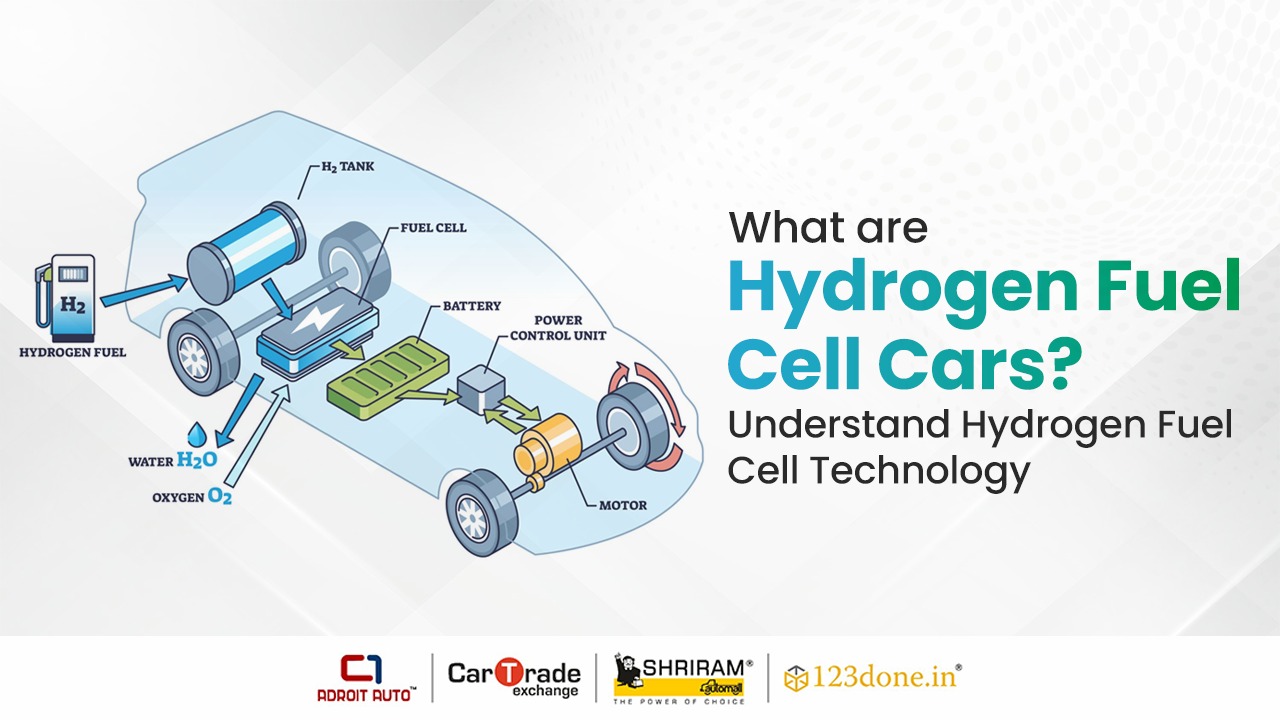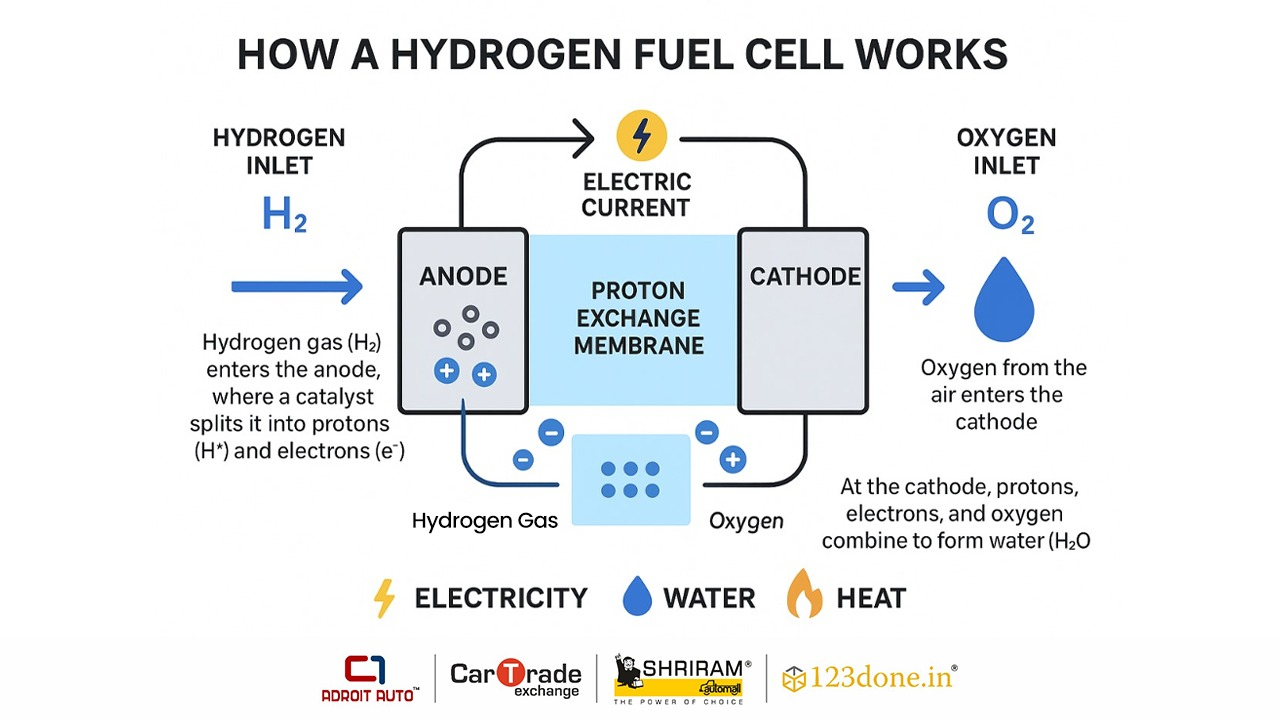What Are Hydrogen Fuel Cell Cars? Technology, Working & Benefits Explained

Some electric cars use hydrogen gas for powering the electric motor with water vapors as the only emission; such cars are known as hydrogen fuel cell cars. These cars combine hydrogen and oxygen in a fuel cell to generate electricity. This whole process is very eco-friendly and efficient. Understanding the hydrogen fuel cell technology in today’s time is very important. The needed infrastructure for hydrogen fuel cell cars is, however, not sufficient. Still, they offer various advantages such as quick refueling and long ranges, similar to traditional fuel engine cars. This blog will give you all the insights into what hydrogen fuel cell cars are and everything you need to understand about fuel cell technology.
What Are Hydrogen Fuel Cell Cars
Hydrogen fuel cell cars are vehicles that use alternative fuels, and in this case, hydrogen. Hydrogen fuel cell cars are electric cars that use a hydrogen-powered fuel cell to produce electricity. These cars are recharged faster in comparison to other electric vehicles that draw electricity directly from the battery. The hydrogen fuel cell technology is indeed a revolution for the automotive industry due to its eco-friendly nature. There are no emissions other than water vapor.
Parts of Hydrogen Fuel Cell Cars
Let us have a look at the key components of a hydrogen fuel cell car to understand the technology behind them:
Battery
Every electric car is equipped with a battery for generating power. Different elements power this battery. In hydrogen fuel cell cars, this battery is powered by hydrogen gas. The car hence works because of this battery.
Battery Pack
The regenerative braking produces energy, which is stored as supplemental power. The battery pack stores this high-voltage power to be used in times of need.
Electric Traction Motor and Fuel Tank
This motor gets power from the fuel cell and the traction battery pack for moving the wheels of the car forward. The fuel tank stores hydrogen gas in the vehicle until it is needed by the fuel cell for the production of electricity.
DC Converter
The high-voltage DC power from the traction battery pack needs to be converted into lower DC power for running the vehicle. This is done with the help of a DC converter, which also helps recharge the battery.
Fuel Cell Stack and Filler
Many membrane electrodes use hydrogen and oxygen to produce electricity, which is known as a fuel cell stack. The fuel filler is a nozzle in the fuel dispenser that is attached to the receptacle for tank filling.
Power Electronics Controller
This is a unit that helps manage the flow of electrical energy delivered by the fuel cell and the traction battery. It also controls the speed of the electric motor and the torque.
Thermal Cooling System
This is a system that helps to maintain proper temperature for the operation of the fuel cell, electric motor, power electronics, and other components.
Electric Transmission
This system helps transfer the mechanical power from the electric traction motor to drive the wheels of the vehicle.
Hydrogen Fuel Cell Technology
The hydrogen fuel cell technology is used to convert hydrogen and oxygen into electricity with the help of an electrochemical reaction, with water and heat as the only byproducts. The hydrogen fuel technology is considered to be a proven energy source that is more efficient than traditional combustion engines. This technology is being used in transportation, stationary power, and more.
Let us understand the working of hydrogen fuel cell technology:

Conclusion
Hydrogen fuel cell cars have proven significance in today’s time toward a cleaner and more sustainable automotive future. By using the hydrogen fuel cell technology, the vehicles can convert hydrogen and oxygen into electricity with an electrochemical process. Hydrogen fuel cell cars deliver efficient performance, fast refueling, and extended driving range. Although the infrastructure of hydrogen fuel cell cars is still not enough, the potential that it holds is immense. Understanding the technology of hydrogen fuel cell cars will surely be a great step towards green transportation and the future of sustainable mobility.
Frequently Asked Questions (FAQs)
1. What is a hydrogen fuel cell car, and how does it work?
A hydrogen fuel cell car uses hydrogen gas to produce electricity through a chemical reaction with oxygen. This electricity powers the car’s motor, and the only emission released is water vapor, making it an eco-friendly vehicle option.
2. Are hydrogen fuel cell cars better than electric cars?
Hydrogen fuel cell cars offer faster refueling times and longer driving ranges compared to battery-electric cars. However, electric cars currently have better infrastructure and charging accessibility.
3. What are the main advantages of hydrogen fuel cell technology?
The key advantages include zero harmful emissions, quick refuelling, high energy efficiency, and longer driving range, making hydrogen fuel cell technology a sustainable alternative to petrol and diesel engines.
4. What is the biggest challenge for hydrogen fuel cell cars today?
The biggest challenge is the lack of hydrogen refuelling infrastructure and high production costs. However, ongoing innovations aim to make hydrogen fuel cell cars more accessible and affordable in the future.

 Download Our App
Download Our App



